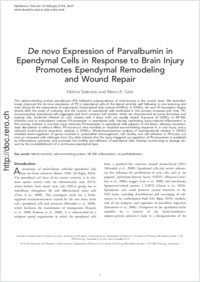De novo expression of parvalbumin in ependymal cells in response to brain injury promotes ependymal remodeling and wound repair
- Szabolcsi, Viktória Anatomy and Program in Neuroscience, Department of Medicine, University of Fribourg, Switzerland
- Celio, Marco R. Anatomy and Program in Neuroscience, Department of Medicine, University of Fribourg, Switzerland
-
2014
Published in:
- Glia. - 2015, vol. 63, no. 4, p. 567-594
English
The calcium-binding protein parvalbumin (PV) hallmarks subpopulations of interneurons in the murine brain. We serendipitously observed the de novo expression of PV in ependymal cells of the lateral ventricle wall following in vivo lesioning and brain slicing for the preparation of organotypic hippocampal slice cultures (OHSCs). In OHSCs, de novo PV-expression begins shortly after the onset of culturing, and the number of ependymal cells implicated in this process increases with time. PV-immunopositive ependymal cells aggregate and form compact cell clusters, which are characterized by lumen-formation and beating cilia. Scratches inflicted on such clusters with a sharp knife are rapidly closed. Exposure of OHSCs to NF-КB-inhibitors and to antioxidants reduces PV-expression in ependymal cells, thereby implicating injury-induced inflammation in this process. Indeed, in vivo stab injury enhances PV-expression in ependymal cells adjacent to the lesion, whereas neuraminidase denudation is without effect. PV-knock-out mice manifest an impaired wound-healing response to in vivo injury, and a reduced scratch-wound reparation capacity in OHSCs. Whole-transcriptome analysis of ependymal-cell clusters in OHSCs revealed down-regulation of genes involved in cytoskeletal rearrangement, cell motility and cell adhesion in PV-knock out mice as compared with wild-type mice. Our data indicate that the injury-triggered up-regulation of PV-expression is mediated by inflammatory cytokines, and promotes the motility and adhesion of ependymal cells, thereby contributing to leakage closure by the re-establishment of a continuous ependymal layer.
- Faculty
- Faculté des sciences et de médecine
- Department
- Département de Médecine
- Language
-
- English
- Classification
- Biological sciences
- License
- License undefined
- Identifiers
-
- RERO DOC 234247
- DOI 10.1002/glia.22768
- DOI 10.1002/glia.22768/suppinfo
- Persistent URL
- https://folia.unifr.ch/unifr/documents/304181
Statistics
Document views: 77
File downloads:
- cel_dne.pdf: 339
